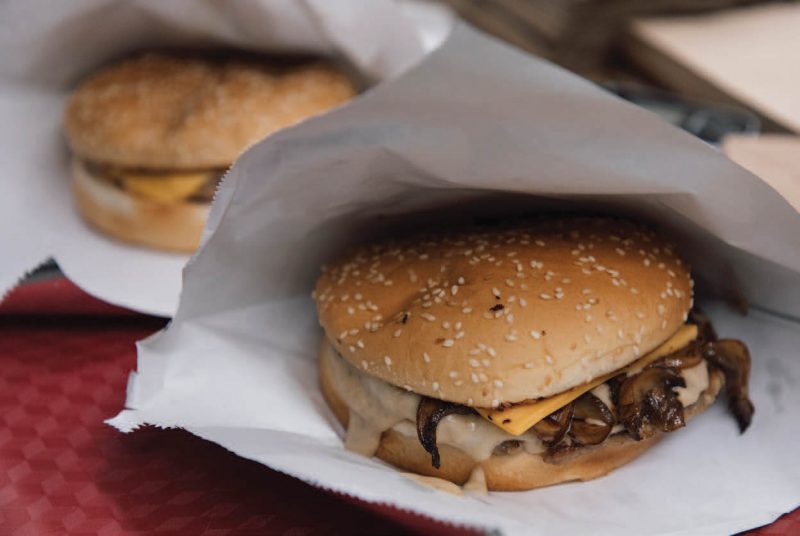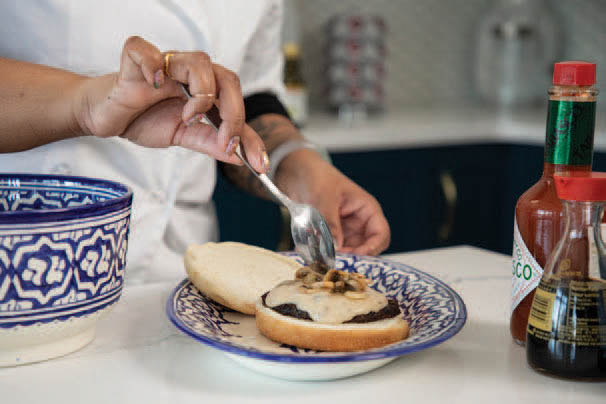
This article originally appeared in the Fall 2021 print issue of Quench Magazine and is a 2022 National Magazine Awards nominee in the Short Feature Writing category.
A MUSHROOM BURGER IS, WELL, A BURGER WITH MUSHROOMS.
After that, sky’s the limit. It might be topped with white cheese, yellow, blue cheese, onion rings, avocado—whatever floats your ‘shroom. They have no hard-fast rules and tend toward distinguished tastes, which is probably the reason you won’t find them at many fast-food chains.

But there’s one region of the world where the mushroom burger is a definable entrée—a sizable beef patty smothered in sautéed canned mushrooms and sauce comprised mostly of cream of mushroom soup. You’ll find it across Alberta and inland British Columbia, and the mountains of Lebanon—homeland of the man who popularized it in Western Canada.
Riad “Rudy” Kemaldean obviously didn’t bring the burger recipe with him from his home village in the 1950s when he immigrated with his brother. He found the sauce in Edmonton at one of a few remaining Burger Bar-ons, a floundering fast-food shack that made a roaring comeback after he bought it. Joined by his relatives, the Kemaldeans/Kamaleddines (spelling varies depending on which brother filed the paperwork) soon had a dozen Burger Barons under their spell. After civil war broke out in Lebanon, these restaurants became training grounds for future Lebanese restaurateurs who took the recipes with them when it was time to strike out on their own.
Some of them even took the name.
While the mushroom burger recipe is standardized, the Burger Baron franchise isn’t. It’s not really even a franchise. It went bankrupt in 1961, a few years before the Lebanese immigrants discovered it, and since creditors never bothered to sell the brand’s intellectual property, and Jack McDonnell—the inventor—never
thought to will it to his family, the entire brand is basically public domain.
The McDonnell and Kemaldean families did manage to band together eventually and reregister the trademarks in 1996, but the legal grounds of their corporate ownership are shaky. Regardless, you can’t patent a recipe — only an original ingredient — and so their secret mushroom sauce remains part of the collective memory of Lebanese Canadians.
“That mushroom sauce is important—it’s iconic,” says Judy Schulz, who first tasted the mushroom burger on an assignment for the Edmonton Journal in the early ’80s.” Then the paper’s dining out critic, she had prejudices against hamburgers, but the Journal wanted her to review something more accessible to readers in the blue-collar city.
Schulz begrudgingly drove to four fast-food joints, bought one burger from each, and brought them back to the office. “The mushroom burger won, hands down.”
Only a few Burger Barons remain in Edmonton, but you’ll find the iconic burger at mom and pop diners throughout the city and beyond. Whether the restaurant owners call their establishment Burger Baron, Burger Barn, Baron Family Restaurant, or something else completely, their businesses thrive mostly in rural communities. I’m related to several of them, and one, the owner of Boondocks
Grill in High Prairie, 370 kilometres north of Edmonton, is my brother Ali.
Think of these diners as the Lebanese version of the small-town Chinese or Greek restaurant, only you’re more likely to find spring rolls and souvlaki on the menu than tabbouleh. Their offerings vary depending on the local competition. One of the only things they agree on is that one burger.
Despite the discrepancies between them, their mushroom burgers are remarkably consistent. Ali learned the recipe from our dad, back when the family business was in fact called Burger Baron Pizza & Steak. Our dad apprenticed with his uncle, who bought one of the original Burger Barons in a neighbouring town from another Lebanese man, who apprenticed with Rudy in the ‘70s. I have tasted all four of their mushroom burgers—and many more spanning Alberta—and they all strike the same balance of tanginess, saltiness, and soupiness.
The sauce base is an open secret. Nothing can conceal the distinctiveness of Campbell’s Cream of Mushroom soup, and the restaurant owners have given up trying. “The first time I tasted that mushroom sauce, I was eight years old again, back in my mom’s kitchen,” says Schultz, “and I can see her opening that can of mushroom soup, which I think plays heavily in the mushroom sauce. The mushroom sauce is very much like that. The taste, the smell, the texture—it brings it all back.”
It’s the other ingredients that are harder to pin down, even for a career foodie like Schultz. “I think there may be some mayonnaise or lemon juice, or something—there’s just a nice little note there, off to the side.” My childhood memories of the back of the restaurant conjure up rows of jumbo-sized mushroom soup cans, but not a lot of mayonnaise jars and definitely not lemon juice.
The owners guard the secret closely, even though they themselves got it through a breach of security. A former kitchen staff of the now defunct Burger Bank food truck told me his boss used to make him wait outside while he assembled the sauce.
I recently interviewed many Lebanese restaurateurs for a documentary about the Burger Baron. Nobody was willing to share the recipe completely with the exception of Sam Chehdi. The long-time restaurateur in Mayerthorpe (population: 1,320) insisted the sauce is nothing more than soup, straight out of the can. To prove it he proceeded to cook mushroom burgers this way for us while our cameras rolled. He then fed them to our crew. Though it was a very tasty burger, something tasted off.
Walid Sahr of Whitecourt, who immigrated in 2000 and got into the business based on his
first transcendent experience with a mushroom burger, fessed up to three additives—soya sauce, Tabasco, Worcestershire—then, somewhat suspiciously, added
“there are some spices.”
“Sumac? Cumin?” I asked.
“I don’t like to talk about that.”
Khalid “Kelly” Kamaleddine, who kicked my film crew out of the stock room of his Edmonton Burger baron, denied using any spices, but insisted there was a fifth ingredient, plus a specialty soya sauce. I wasn’t sure if these were red herrings. When I pressed him, he said, “Go ask your dad.”
I did—but my dad, long retired, could not remember the proportions or whether there was in fact a fifth ingredient. So, I asked my brother.
Ali could only recall it the way he was taught using industrial soup cans. Indeed, his recipe was a square dance of soup, Tabasco, soya, and Worcestershire.
Does he cook the soup or thin it out with water? I asked. No—but make sure the soup is Campbell’s recipe. “No low sodium or fat.”
“Does the soya have to be anything special?”
“Yes, very.”
“Really?”
“Nope,” he replied with a laugh. “We use Wings. Have used China Lily”
I took the recipe back to a stage kitchen where we recreated it with the intention of revealing the recipe for the movie. After sharing a photo of our success on Instagram, we received complaints from members of the Kemaldean family. Nobody served us a cease and desist. They simply reminded me of what this is truly a recipe for.
“Families like yours and many others were given a chance at making something for them-selves,” the daughter of retired Burger Baron owners told me. There may not be a patent to the brand and food, and each location may have mastered their own style of the sauce, but she hoped that we would covet this one secret to living out the immigrant dream.
And so, for now, it remains a trade secret of the Lebanese burger mafia.
Omar Mouallem is an award-winning writer and filmmaker. His second film, The Last Baron, which documents the unlikely link between fast-food and Lebanese refugees, and second book, Praying to the West: How Muslims Shaped the Americas, are both set for release this fall. His favourite comfort food is, perhaps surprisingly, not a mushroom burger (its lebneh).


